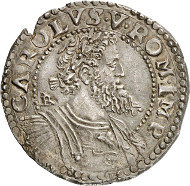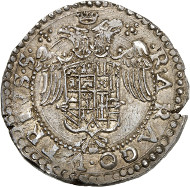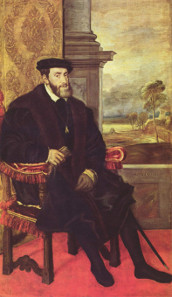courtesy of the MoneyMuseum, Zurich
translated by Teresa Teklic
Why was the human head the motif on coins for centuries, no, for millennia? And why did that change in the last 200 years? Ursula Kampmann is looking for answers to these questions in her book “Menschengesichter” (“Human faces”), from which the texts in this series are taken.
Charles V, King of Spain (1516-1556). Holy Roman Emperor (since 1519). Half ducato, around 1552. Armour-clad bust of Charles with laurel wreath to the right. Rv. Coat of arms of Charles V, crowned, double-headed eagle in the background. © MoneyMuseum, Zurich.
What a boring coin reverse! Charles V really could have thought of a more interesting motif here! If we think that this coat of arms is boring, it’s only because we have forgotten how to read it. The contemporary beholder would have immediately recognised the major significance attributed to the coin’s minting authority by this coat of arms.
In the top field, those countries are depicted which were inherited by Charles V from his mother Joanna, called Joanna the Mad. She was the only child of Isabella I of Castile and Ferdinand of Aragón. Isabella brought Castile and the adjoined Leon into the marriage, Ferdinand Aragon, Catalonia and Navarre. The pomegranate on the bottom is a symbol for Granada, taken from the Moors by Isabella and Ferdinand in 1492.
The bottom left field depicts the escutcheon of a country inherited by Charles V from his father. Philip the Fair was the only heir of Holy Roman Emperor Maximilian I and Mary of Burgundy. The only part of his paternal inheritance which finds a heraldic representation here is Austria. This may be due to the fact that, in a division of their grandfather’s estates, most of the estates went from Charles’s into Ferdinand’s I possession because Ferdinand had kept his promise and renounced his candidature for Holy Roman Emperor.
Charles’s I empire. (ruby: Castile/ red: Aragon/ orange: Burgundy/ yellow: Austrian hereditary lands/ light yellow: Holy Roman Empire). Source: Lucio silla/Paul2 / http://creativecommons.org/licenses/by-sa/3.0/deed.en
Three fields are dedicated to the estates which Charles inherited from his great-grandfather Charles the Bold: New Burgundy, Old Burgundy and Brabant.
The bottom right shows a newly acquired possession of the House of Habsburg: Hungary, which belonged to the Habsburg Empire since its king had died in the Battle of Mohacs in 1526. In this case, Ferdinand I became king by contract of inheritance.
Since this coin was minted in Naples, it is surprising that the coats of arms of both Sicilies are missing. After all, these two territories, as part of Aragón, also belonged to Charles’s empire. What is missing in the imagery is added by the inscription. It reads (in translation): “King of Aragón and both Sicilies”.
Titian (or Lambert Sustris), portrait of Charles V, 1548. Source: Wikicommons.
So Charles only represents a small part of his possessions on this coin, carefully choosing those territories in which most of his power rested. It is remarkable that Charles did not attach any major importance to the New World, although today, in retrospect, we know better.
In the next episode, Francis I of France will try to attack Charles – and fail.
You can find all episodes in the series here.
A German edition of the book “Menschengesichter” is available in print and as ebook on the site of the Conzett Verlag.







